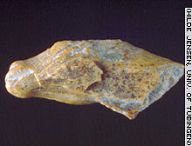

the archetypal mythology of horses
Copyright
2004-2022 Beverley Kane, MD
Page 6 of 20
"higher" mammal.
In an analogous way, oneirogeny—the
creation of dreams by the dream ego—recapitulates
mythogeny. That is, dreams reënact the history of
myth and replay the primitive, modern, and universal
dramas of myth, legend, and fable. We dream
ourselves in more primitive physical as well as
psychological forms. Scenarios of animals behaving
idiosyncratically and other fantastic dream scenarios
lend the power of myth to our night dreams. That is
what Freud meant when he said, "Myths are the
dreams of the race; Dreams are the myths of the
individual."
EVOLUTION OF THE ARCHETYPE—FROM DARWIN TO DISNEY
Horses evolved 60 million years ago as Eohippus, a 4-toed, leaf-eating forest dweller
with approximately the habitus of a medium-size dog. Today's horse, Equus caballus,
has been known for 20 million years. Late Paleolithic (-35,000 to –8000
*
) humans
hunted wild horses for food, evidently used them in ritual, and vividly depicted them in
cave art found all over Europe and, from a later period, in Asia Minor.
As an herbivore, the horse preys on no other animals, but is itself the target of
predators such as large cats and wolf packs. Most horses take flight under stress, but
when domesticated for ranching and battle, have been known for their bravery,
aggression, and selflessness.
Some historians have proposed that the horse was first
domesticated by migratory reindeer herders in Northern Europe, who by –5,000 rode
reindeer and hunted horses, and somewhat later by the Proto-Indo-Europeans on the
Ukrainian steppes.
Beginning in the -3rd millennium, and over a period of 3,500 years, pastoralist
horse peoples from the Pontic-Caspian steppes began a methodical migration into
Europe, Anatolia (current day Turkey), the Indus region, and Western Siberia. The new
settlers underwent in part a syncretic absorption of the agrarian and mercantile native
societies. There is also archeological evidence of horse and chariot warfare, whereby
invaders forcefully conquered indigenous populations. In essence, the horse evolved
from a draft animal, to a warrior's steed—both harnessed to chariot and mounted—to a
form of general transport.
4
As the horse evolved in relation to humans, from food source in –35,000 to
domesticated laborer in –5000 to warrior steed in -2000 to sporting companion, he
appeared in different roles in myth and projection. We can only wonder what the
Lascaux cave artists were thinking in –14,000 when they painted horses inside the caves.
Were they thinking in terms of art for art's sake, religious iconography and ritual, or
*
Negative numbers designate dates "Before Christ" or "Before the Common Era."
Ivory carving of a horse
found at Hohle Fels Cave
in southern Germany. –
33,000


